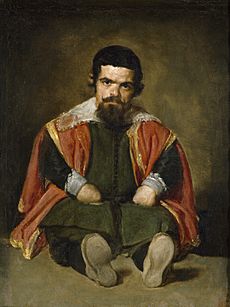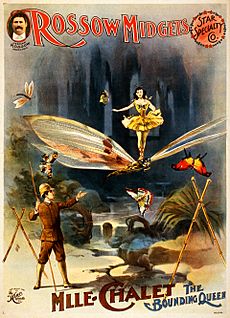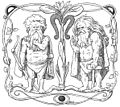Dwarfism facts for kids

Dwarfism describes a person who is much shorter than average. Usually, this means someone is less than 4 feet, 10 inches (147 cm) tall. Often, this short height is due to a medical condition. People with dwarfism are sometimes called dwarfs or little people.
There are two main types of dwarfism. In disproportionate dwarfism, some body parts are shorter than others. For example, a person might have a regular-sized torso but very short arms and legs. In proportionate dwarfism, all body parts are smaller than average, but they are still in proportion to each other.
More than 200 different medical conditions can cause dwarfism. The most common type is achondroplasia. This is a genetic disorder where the arms and legs are short compared to the body. It accounts for about 70% of all dwarfism cases. Another common cause is Growth hormone deficiency. This happens when the body does not make enough growth hormone.
Contents
Understanding Dwarfism
Many people with dwarfism live full and active lives. They might need some special tools or changes to their environment. For example, they might use furniture that is a different size.
Medical Care and Support
Treatment for dwarfism depends on what causes it. For some genetic disorders, surgery or physical therapy can help. If dwarfism is caused by a hormone problem, doctors can sometimes give growth hormone therapy. This treatment works best before a child's growth plates (areas where bones grow) close.
Many support groups exist to help people with dwarfism and their families. These groups offer advice and a sense of community. They also work to help people understand dwarfism better.
Respectful Language
It is important to use respectful words when talking about people with dwarfism. In English-speaking countries, accepted terms include dwarf (plural: dwarfs), little person (LP), or person of short stature.
Historically, the word "midget" was sometimes used. However, this term is now considered offensive. It is best to avoid using it.
Dwarfism in History
Throughout history, people with dwarfism have been part of society in different ways. In the 19th century, some people with dwarfism became famous performers. For example, in the United States, they were often a major attraction in circus sideshows. Two very famous little people from this time were General Tom Thumb and Michu.
Images for kids
-
Dwarfism can also happen in animals. This horse has achondroplastic symptoms, similar to some humans.
-
Seneb was an important official and priest in Ancient Egypt. This statue shows him with his wife, Senetites, and their children.
-
Lavinia Warren was an actress who had pituitary dwarfism, which is caused by a growth hormone deficiency.
-
This image shows two Norse dwarfs. It is from a 19th-century book called the Poetic Edda (1895) by Lorenz Frølich.
See also
 In Spanish: Enanismo para niños
In Spanish: Enanismo para niños






